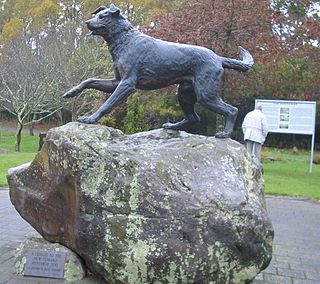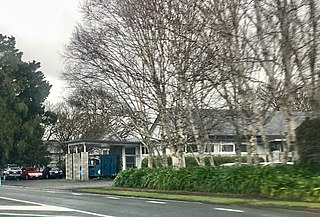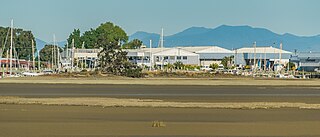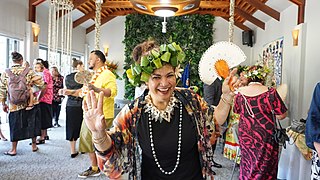
The demographics of New Zealand encompass the gender, ethnic, religious, geographic, and economic backgrounds of the 5.2 million people living in New Zealand. New Zealanders predominantly live in urban areas on the North Island. The five largest cities are Auckland, Wellington, Christchurch, Hamilton, and Tauranga. Few New Zealanders live on New Zealand's smaller islands. Waiheke Island is easily the most populated smaller island with 9,420 residents, while Great Barrier Island, the Chatham and Pitt Islands, and Stewart Island each have populations below 1,000. New Zealand is part of a realm and most people born in the realm's external territories of Tokelau, the Ross Dependency, the Cook Islands and Niue are entitled to New Zealand passports.

Canterbury is a region of New Zealand, located in the central-eastern South Island. The region covers an area of 44,503.88 square kilometres (17,183.04 sq mi), making it the largest region in the country by area. It is home to a population of 666,300.

Eketāhuna is a small rural settlement, in the south of the Tararua District and the Manawatū-Whanganui region of New Zealand's North Island.
Flaxmere is a township in the Hastings District and outlying suburb of Hastings City, in the Hawke's Bay Region of New Zealand's North Island. It consists of a series of cul-de-sacs, radiating from a main street.

Hunterville is a small town in the Rangitikei district of the North Island of New Zealand. It is located halfway between Taupo and Wellington on State Highway 1, and as of the 2018 census has a population of 408.
Waharoa is a rural community in the Waikato region of New Zealand's North Island. It is located 7 km north of Matamata, and is part of the Matamata-Piako District. It is located at the junction of the Kinleith Branch railway and the East Coast Main Trunk Railway. State Highway 27 runs through the town, which is serviced by several shops and cafes and by a petrol station. Matamata Airport is just over 3 km (1.9 mi) north of Waharoa.
Korean New Zealanders, also referred to informally as Korean Kiwis, Kokis or Kowis, are New Zealand citizens and residents of Korean ancestry. The 2018 New Zealand census found 35,664 Koreans in the country, virtually all from South Korea, making them the third-largest Asian population there, and more than 0.75 percent of the total population of New Zealand.
American New Zealanders are New Zealand citizens who are of American descent of American-born citizens from the United States. American New Zealanders constitute a small minority of New Zealand's population.

Ōhaupō is a rural community in the Waipa District and Waikato region of New Zealand's North Island. It is located on State Highway 3, about halfway between Hamilton and Te Awamutu.
Asian New Zealanders are New Zealanders of Asian ancestry . At the 2013 census, 471,708 New Zealanders declared that they had an Asian ancestral background. This represents about 12% of all responses.
The 1911 New Zealand census was New Zealand's fifteenth national census. The day used for the census was Sunday, 2 April 1911.
The 2018 New Zealand census was the thirty-fourth national census in New Zealand, which took place on Tuesday 6 March 2018. The population of New Zealand was counted as 4,699,755 – an increase of 457,707 (10.79%) over the 2013 census.
Tongan New Zealanders are Tongan immigrants in New Zealand, their descendants, and New Zealanders of Tongan ethnic descent. They constitute one of New Zealand's most sizeable ethnic minorities. In the 2013 census, 60,336 New Zealanders identified themselves as being of Tongan ethnicity with 22,413 stating that they were born in Tonga.

Ngāhinapōuri is a rural community in the Waipa District and Waikato region of New Zealand's North Island. It is located on State Highway 39, between Whatawhata and Pirongia.
Rukuhia is a rural community in the Waipa District and Waikato region of New Zealand's North Island.

Kawaha Point is a suburb of Rotorua in the Bay of Plenty Region of New Zealand's North Island.
Tawhero is a suburb of Whanganui, in the Whanganui District and Manawatū-Whanganui region of New Zealand's North Island.

Lower Moutere is a settlement in the Tasman District of New Zealand's upper South Island. It is a farming community it the Lower Moutere valley, 6 km (3.7 mi) from Motueka close to the Moutere Inlet.

Pasifika New Zealanders are a pan-ethnic group of New Zealanders associated with, and descended from, the indigenous peoples of the Pacific Islands outside of New Zealand itself. They form the fourth-largest ethnic grouping in the country, after European descendants, indigenous Māori, and Asian New Zealanders. Over 380,000 people identify as being of Pacific origin, representing 8% of the country's population, with the majority residing in Auckland.
Mission Heights is an eastern suburb of Auckland, New Zealand, comprising Mission Heights North and Mission Heights South. It is located in the wider suburb of Flat Bush.








